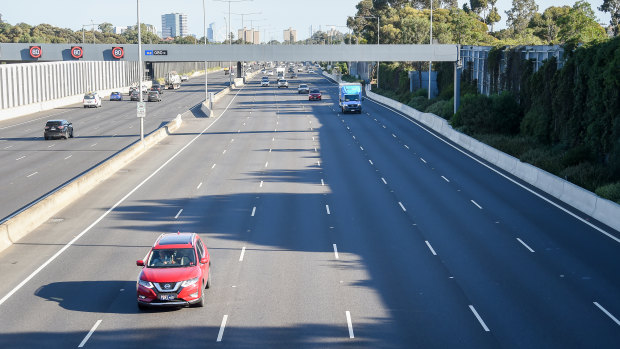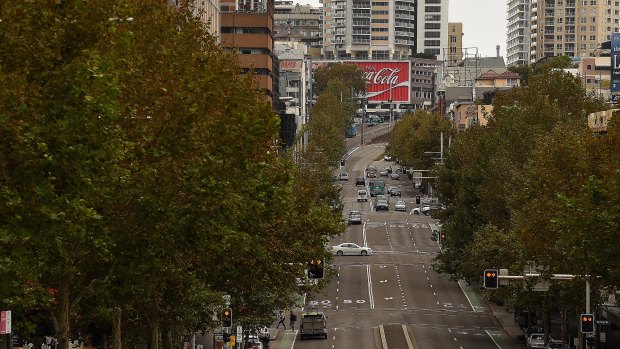This was published 5 years ago
How coronavirus turned peak hour into a Sunday morning drive
By Craig Butt
Traffic congestion throughout the country has fallen dramatically as people heed calls to avoid unnecessary travel, new analysis shows, with peak-hour traffic in the major cities now flowing as freely as on a typical Sunday morning.
During evening rush hour last Thursday, analysis from location data company HERE Technologies revealed 1.8 per cent of Melbourne’s major roads were congested, far fewer than the 19.8 per cent typically clogged at this time of week.
The HERE analysis revealed 5pm to 5.15pm was normally the worst time of the week for traffic congestion in Melbourne, but last week the city’s roads were experiencing the sort of free-flowing traffic usually seen at 9.30am on a Sunday morning.
Using the interactive slider above, you can compare the typical traffic congestion during the Thursday evening peak with what it was like at this time last Thursday. The scale goes from dark red for heavily congested roads to green for free-flowing traffic.
As you can see, typical traffic congestion during Thursday peak hour in Melbourne tends to be worst on Punt Road and the West Gate Freeway in both directions, as well as outbound on CityLink. Meanwhile, the Hoddle grid is straining under all the office workers starting to make their way home by car.
But last Thursday, the entirety of the Hoddle grid was outlined in free-flowing green (aside from those black lines which signify roadworks), as was the West Gate Freeway and Punt Road. The only hint of red was a small section of CityLink outbound.

Peak-hour traffic on the Tullamarine Freeway on Thursday, March 26. Credit: Justin McManus
HERE Technologies Oceania head Daniel Antonello said it was hard to pinpoint exactly why Thursday at 5pm was typically Melbourne’s busiest period.
“I’d imagine Thursday late-night shopping is a big factor,” he said. “I’d also imagine restaurants and bars are somewhat busier on a usual Thursday compared to other weeknights.”
Last Thursday, bars throughout Australia were ordered to close to prevent coronavirus from spreading, while restaurants were restricted to only offering takeaway food. By that stage, retailers had also started to close their doors and shopping centres were turning into ghost towns.
In the CBD, pedestrian traffic was also far below average, as fewer people drove or caught public transport to work and many businesses, such as the flagship Myer store in Bourke Street , closed their doors and stood down staff.
Mr Antonello said traffic congestion in Melbourne and Sydney over the past couple of weeks had reduced considerably and that falls had been significant across the entire day.
In Sydney during evening peak hour on Thursday, the HERE data revealed 23 per cent of roads were typically congested; last Thursday only 1 per cent were, which is what you would expect on a Sunday morning at 9am.
The level of traffic congestion was measured by HERE using GPS data and other sources of information.
A Department of Transport spokeswoman said the reduction in traffic coincided with more people working from home. "Our message is clear – stay home. There are only four reasons to leave your home: food and supplies, medical care, exercise, and work or education," she said.
HERE’s observations of reduced traffic volumes also tallied with other data. On Wednesday, toll road operator Transurban reported a 43 per cent drop in traffic on its Melbourne airport toll road, a 29 per cent fall on its Sydney roads and a 27 per cent slide in its Queensland assets over the last week of March.

A very empty William Street in Sydney on Wednesday during what would normally be heavy peak-hour traffic.Credit: Kate Geraghty
Mr Antonello said the long-term impact on commuter behaviour would be interesting.
“Some people may choose to continue working from home, even a couple of days a week or month, in a bid to avoid hours of commuting.”
Swinburne University senior lecturer in logistics John Hopkins said it would greatly reduce congestion if people worked from home one or two days per week, once major cities returned to normal.
“If everybody who wasn’t working from home before starts working from home more regularly, that will have a massive impact on congestion.
"Not only that, it will have a massive impact on future infrastructure projects and even the need for them,” he said.
Below are the interactive sliders for other major cities: